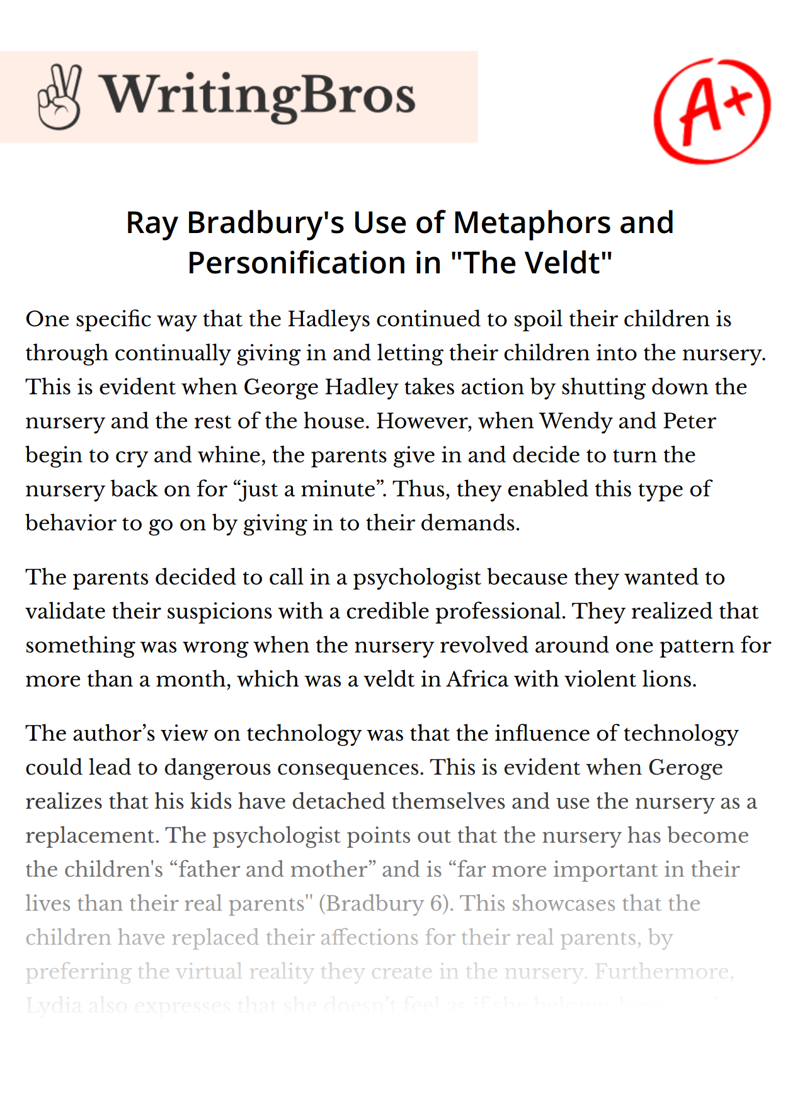Ray Bradbury's Use of Metaphors and Personification in "The Veldt"

One specific way that the Hadleys continued to spoil their children is through continually giving in and letting their children into the nursery. This is evident when George Hadley takes action by shutting down the nursery and the rest of the house. However, when Wendy and Peter begin to cry and whine, the parents give in and decide to turn the nursery back on for “just a minute”. Thus, they enabled this type of behavior to go on by giving in to their demands.
The parents decided to call in a psychologist because they wanted to validate their suspicions with a credible professional. They realized that something was wrong when the nursery revolved around one pattern for more than a month, which was a veldt in Africa with violent lions.
The author’s view on technology was that the influence of technology could lead to dangerous consequences. This is evident when Geroge realizes that his kids have detached themselves and use the nursery as a replacement. The psychologist points out that the nursery has become the children's “father and mother” and is “far more important in their lives than their real parents'' (Bradbury 6). This showcases that the children have replaced their affections for their real parents, by preferring the virtual reality they create in the nursery. Furthermore, Lydia also expresses that she doesn’t feel as if she belongs because the technology in the house acts as a “wife and mother” (2). This displays her feeling of worthlessness as she knows that she cannot compete with technology. This drives a wedge in her mind between her duties as a mother and wife in the house which causes her to feel inadequate.
One example of a literary device in the text is a simile as the author describes the children when they come back. For instance, in the text it describes that the children had “cheeks like peppermint candy, eyes like bright blue agate marbles” (4). Using the keyword “like” in this example compares the two different things to indicate a similarity.
The author also uses personification by giving the house human traits in the text. For example, in the text it states “This house which clothed and fed and rocked them to sleep and played and sang and was good to them” (1). This description of the house indicates that the house is essentially a caregiver by looking after everyone in it. By assigning these human traits to an inanimate object, the author is effectively using personification as a literary device.
Lastly, the author uses allusions as a literary device when he references other well-known stories. This occurs when George wonders why the nursery always projects Africa instead of other popular children’s stories. The reference mentions “Alice in Wonderland”, “Aladdin and his Magical Lamp”, and “Dr. Dolittle” (3). By mentioning these other stories, the author is able to enhance the significance behind the fact that the nursery is always of a veldt in Africa.
Compare George Hadley in The Veldt to Marge Simpson in The Simpsons episode “You Only Move Twice.” What vices do they take up? (1 mark) Why do you think they do this? In The Veldt, George Hadley begins to feel unnecessary and unsure of what to do with himself in his own house. His wife points out that he is smoking, drinking, and taking sedatives more often. Similarly, Marge Simpson in The Simpsons episode “You Only Move Twice” starts drinking a glass of wine every day because she finds that she has nothing to do all day. I think characters will indulge more in their vices such as drinking more often because they aren’t used to this feeling of inadequacy. Furthermore, coupled with the loss of your regular routine due to a dependence on technology taking over, one might feel more inclined to give in to their vices and relax. With the feeling of nervousness that both George and Marge feel, it makes them more inclined to take up more vices in order to cope.
Cite this Essay
To export a reference to this article please select a referencing style below

